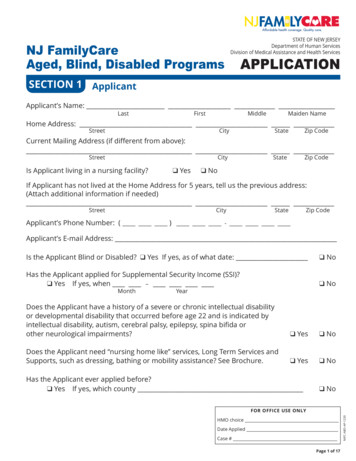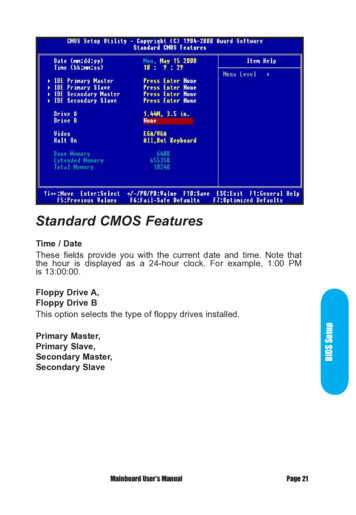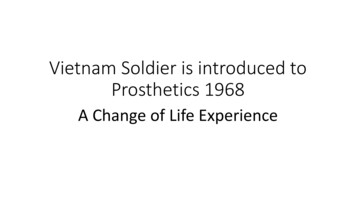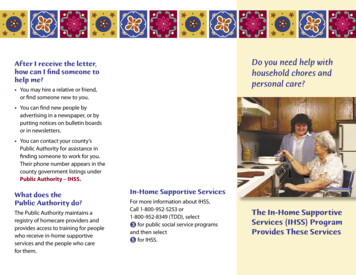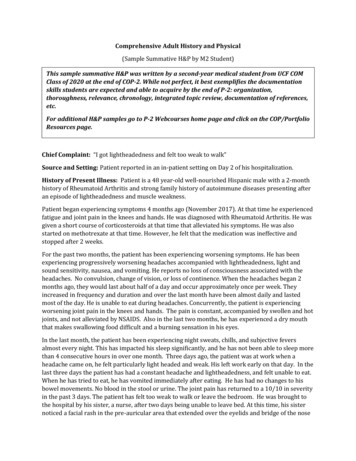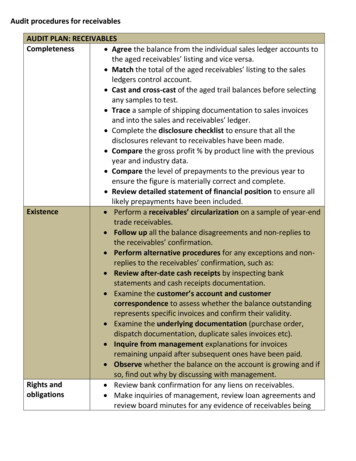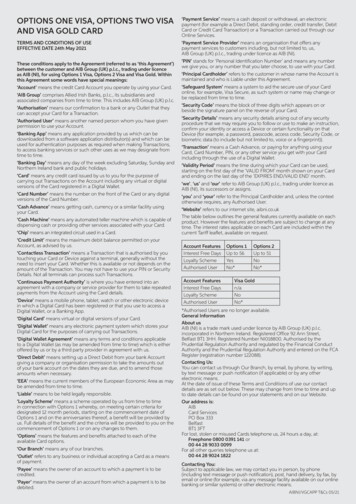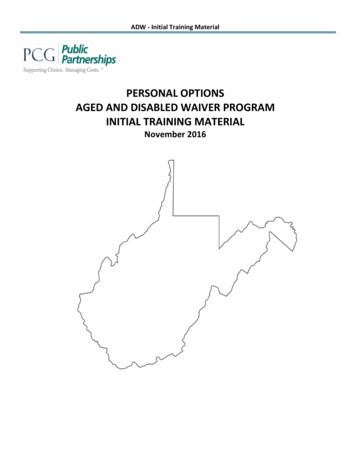
Transcription
ADW - Initial Training MaterialPERSONAL OPTIONSAGED AND DISABLED WAIVER PROGRAMINITIAL TRAINING MATERIALNovember 2016
ADW - Initial Training MaterialTraining OutlinePage21. Personal Attendant Orientation2. Training Areas:A. Universal Precautions (OSHA)611B. Personal Attendant Skills20C. Abuse, Neglect, and ExploitationD. Health Insurance Portability and Accountability Act (HIPAA)2426E. Personal Attendant EthicsF. Health and Welfare for Person Receiving Services3035G. Person-Centered Planning383. Attendant Safety in the Home404. Fraud Prevention5. Important Information Regarding Timesheets6. Attendant and Caregiving Wellness and Resources414243Appendix 1: Incident Report Form44Appendix 2: APS Report FormAcronyms ListADWAPSCMCPRHIPAANEMTOSHAPAPORC11/1/2016Aged and Disabled WaiverAdult Protective ServicesCase ManagerAdult Cardiopulmonary ResuscitationHealth Insurance Portability and Accountability ActNon-Emergency Medical TransportationOccupational Safety and Health AdministrationPersonal AttendantPersonal optionsResource Consultant1
ADW - Initial Training Material1. PERSONAL ATTENDANT ORIENTATIONA. PURPOSE OF THE TRAINING MANUALThis manual has been developed by PPL to assist employees of Personal Options, Aged and Disabled Waiver (ADW) Programto complete their initial training requirements. This manual is to provide general information and resources to assist withinitial and annual training for Personal Attendants. It is also intended to provide wellness information and resources forPersonal Attendants and care giving staff as they provide critical supports to ADW participants.Personal Options Personal Attendant staff must be at least 18 years of age. All paid Personal Attendants must complete allof the following training areas before providing paid services to ADW participants: Adult Cardiopulmonary Resuscitation (CPR) First Aid Universal Precautions (OSHA – Occupational Safety and Health Administration) Personal Attendant Skills Abuse/Neglect/Exploitation Identification Health Insurance Portability and Accountability Act (HIPAA) Direct Care Ethics Health and Welfare for Person Receiving Services Person-Centered PlanningIn addition to the required initial training, Personal Attendant staff will be requiredto complete the following training annually: Universal Precautions (OSHA) Abuse/Neglect/Exploitation Identification Health Insurance Portability and Accountability Act (HIPAA) 4 hours of training focused on enhancing Personal Attendant service delivery knowledge and skills. Specific on-thejob training may be counted toward this requirement.Adult Cardiopulmonary Resuscitation (CPR) and First Aid – a copy of the CPR and First Aid cards must be submitted to PPLand must be maintained current as defined by the terms of the certifying agency CPR: Must be provided by a certified trainer from the American Heart Association, American Red Cross, AmericanHealth and Safety Institute, American CPR, National Safety Council, and Emergency Care and Safety Institute. Skills(hands-on) must be demonstrated. First Aid: Must be provided by an agency nurse, a certified trainer, or a qualified internet provider. Please contact your Resource Consultant if you have any questions regarding CPR/First Aid providers and resources.B. WHAT IS PERSONAL OPTIONS?Personal Options is a participant directed program designed to give participants choice and control over their Medicaidservices so they may live as independently as possible in the community. Personal Options is based on the Principles of SelfDetermination.Personal Options allows participants to: Manage a monthly budget for ADW services; Select, hire, and manage their employees to help with their activities of daily living; Determine employees’ work schedules and rates of pay; Verify employees work times and tasks completed, complete employee evaluations; Purchase Personal Attendant services and non-medical transportation;11/1/20162
ADW - Initial Training MaterialHow does Personal Options encourage Person Centeredness?In the Personal Options program, the participant is encouraged to be actively involved in their assessments, planningmeetings and appropriate management of their federally and state provided budgets, employees and programrequirements. As a Personal Attendant, the participant or their family members may share the service plan that wasdeveloped specifically for the participant with assistance from a Resource Consultant (RC) or a Case Manager (CM). Theservice plan will assist your understanding of how the participant would like you to serve them. This is like a job description.As you are being trained, the specifics of your job will be more completely described. The participant is your employer or“boss” and is the responsible person to inform you of your responsibilities. The Resource Consultant, the participant’s familymembers, the program representative, or other informal supports may also assist with your responsibilities.C. PRINCIPLES OF SELF-DETERMINATIONSelf-determination is being able to live the life that one wants with the services and supports if needed.Self-determination is the ability of the participant to make choices to: Exercise control over their life; Achieve their goals; Obtain skills and resources to participate in meaningful roles in thecommunity; Take responsibility for their actions; Determine their future!The Principles of Self-Determination: Freedom to choose a meaningful life in the community Authority over a targeted amount of dollars (individual budget) Support to organize resources to enhance life Responsibility for the wise use of public funds Confirmation of the important leadership role that individuals and families play in the newly re-designed system ofservices and supportsAs an employee of a Personal Options participant, you can provide supports to reinforce these principles. Your “boss” haschosen you, because you understand that he/she wants to have choice and control in their life which you will support.D. FISCAL EMPLOYER AGENT AND EMPLOYEES (PERSONAL ATTENDANTS) ROLES INPERSONAL OPTIONSRole of the Fiscal Employer AgentA participant-directed service program allows participants to make individual choices about what services they receive, howthey are delivered, and by whom.The Fiscal Employer Agent, Public Partnerships, LLC (PPL), is a national organization that is dedicated to assisting theimplementation of participant-directed service programs.PPL provides financial management services for participants and their employees in Personal Options. PPL assists employees with required enrollment and tax paperwork. PPL assists all participants with the IRS requirements that allow them to be employers. PPL assists employees with criminal background check initiation. PPL checks employee training verifications and CPR and First Aid certifications.11/1/20163
ADW - Initial Training Material PPL performs all payroll and tax functions for employees.PPL provides a Customer Service contact number to assist with payroll questions: 1 (866) 429-3465.PPL provides RCs who assist Personal Attendant staff and participants with understanding the Personal Optionsprogram and their roles and responsibilities.Services available to Participants in the Aged and Disabled Medicaid Waiver program are: Case Management (optional) Personal Attendant Non-medical Transportation Nursing AssessmentEmployee / Personal Attendant Roles and Responsibilities:Before being approved to provide services for a Personal Options participant you are requiredto review and sign the Medicaid Provider Agreement and the Employment Agreement statingthat you understand and acknowledge your responsibilities as an employee.Personal Attendant Role in the ADW Program Personal OptionsAs an employee of the participant, you provide Personal Attendant services to participants in the Personal Options program.You are an employee of the participant, not PPL. Instructions for the areas of services you need to provide will be identifiedby an assessment and plan that is developed by the participant, their legal representative, or their program representative,and the Resource Consultant or case management (if applicable).Personal Attendant services are defined as long-term direct care and support services that are necessary in order to enablean individual to return home from a Nursing Facility. A Personal Attendant’s primary function is to provide hands-onpersonal care assistance outlined in the Service Plan. As time permits, Personal Attendants may also provide otherincidental services to personal care assistance such as changing linens, meal preparation, and light housekeeping (sweeping,mopping, dishes, and dusting). At no time may the time spent on incidental services exceed the amount of time spent onhands-on personal care.Personal Attendants will be able to transport the participant for Non-Medical transportation activities, such as essentialerrands or community activities as indicated on the Service Plan. To provide this service for reimbursement, the attendantwill have to have a valid driver’s license, proof of current vehicle insurance and vehicle registration. Non-medicalTransportation cannot be utilized to transport people on the ADW program to any non-emergency medical appointment.The Personal Attendant may be able to provide transportation for the participant to medical appointments by registeringwith the State Plan Service Non-Emergency Medical Transportation (NEMT). The attendant would then be reimbursed forthe miles driven for this service via that program. Personal Attendants would be responsible for keeping records of allreimbursed travel and paid services as this is outside of the employer’s responsibility. Please contact your RC for moreinformation about NEMT.Personal Attendants in Personal Options are responsible for documenting the exact times for providing services and thetasks completed when providing services. The attendant must submit an accurate and approved timesheet, attendant logand transportation invoice in a timely manner in order to receive on-time payments.Employees providing Personal Attendant services: Are responsible for reporting to the CM or the RC on the participant’s health safety, and welfare May not bill for services when the participant is in the hospital, nursing facility or rehab center Are mandated reporters for any suspicion of Abuse, Neglect and Exploitation11/1/20164
ADW - Initial Training Material Must report any incident including but not limited to Abuse, Neglect or Exploitation regarding the participant toChild or Adult Protection Services, the CM and the RCCritical incidents have a high likelihood of producing real or potential harm to the health and welfare of the participant.Critical incidents may involve abuse or neglect.These incidents may include, but are not limited to: Attempted suicide, or suicidal threats or gestures. Suspected and/or observed criminal activity by the participant, participant’s families, health care providers,concerned citizens, and public agencies that compromise the health or safety of the participant. An unusual event such as a fall or injury of unknown origin requiring medical intervention or first aid if abuse andneglect is not suspected. A significant interruption of a major utility, such as electricity or heat in the participant’s residence that compromisesthe health or safety of the participant. Environmental/structural problems with the participant’s home, including inadequate sanitation or structuraldamage that compromises the health or safety of the participant. Fire in the home resulting in relocation or property loss that compromises the health or safety of the participant. Unsafe physical environment in which the workers or PPL staff are threatened or abused, and their welfare is injeopardy. Disruption of the delivery of services, due to involvement with law enforcement authorities by the participantand/or others residing in the participant’s home that compromises the health or safety of the participant. Medication errors by a participant or his/her family caregiver that compromises the health or safety of theparticipant, such as medication taken that was not prescribed or ordered for the participant, and failure to followdirections for prescribed medication, including inappropriate dosages, missed doses, or doses administered at thewrong time. Disruption of planned services for any reason that compromises the health or safety of the participant, includingfailure of participant’s emergency backup plan. Any other incident judged to be significant and potentially having a serious negative impact on the participant.Simple incidents are unusual things that happen to the participant but are not critical and not abuse or neglect.Simple incidents may be: Minor injuries, unknown how they occurred and no pattern Dietary errors with no negative outcomeEmployees/Attendants are responsible: To pass a criminal background check every five years; To maintain valid CPR certification from a “hands-on” course provided by a certified trainer To pass First Aid training; To complete mandatory initial training before working begins; To complete mandatory annual training and 4 hours of additional attendant knowledge and skills; To provide services to the participant for identified and approved tasks on the service plan; To submit accurate and timely timesheets/ transportation invoices to employer for review and signature; To document tasks completed daily on the bi-monthly or monthly Personal Attendant Log (PAL); fax or mail the PALto the RC bi-monthly or monthly; To notify the RC of any changes in the condition of the participant, including death; To notify the RC of any abuse, neglect or exploitation of the participant;11/1/20165
ADW - Initial Training Material To notify the RC of any all incidents or hospitalizations;To be punctual, neatly dressed, and respectful of employer’s person, belongings, family and acquaintances;If providing transportation services, furnish employer with proof of valid driver’s license and automobile liabilityinsurance;Maintain confidentiality of all other participant information, and only release information with the written consentof the participant;To inform the employer of any non-workplace injury that would interfere with the performance of your duties andto report workplace injuries to the participant within 24 hours;Notify the employer in advance if not able to provide services as scheduled or if quitting employment.As an employee/attendant providing services to a participant, it is important that you complete your roles in order forthe participant to maintain compliance on the Personal Options program. Please contact the RC for any questionsregarding your roles or responsibilities.2. TRAINING AREASA. UNIVERSAL PRECAUTIONS (OSHA)Occupational Safety and Health Act of 1970 (OSHA)The purpose of the OHSA regulations are “To assure safe and healthful working conditions for working men and women; byauthorizing enforcement of the standards developed under the Act; by assisting the States in their efforts to assure safe andhealthful working conditions; by providing research, information, education and training in the field of occupational safetyand health; and for other purposes.”As an employee in Personal Options, you are protected under this Act which statesthat employers shall furnish a place of employment which is free of recognized hazardsthat are likely to cause physical harm or death to employees.The two primary standards that pertain to your work are: Blood borne pathogens (BBP) Hazard Communication (HAZCOM) Blood borne Diseases include:- Several strains of Hepatitis including Hepatitis B and C- Syphilis- Malaria- Human Immunodeficiency Virus (HIV)- MRSA - Methicillin-Resistant Staphylococcus aureusAs an employee you may be exposed to Hepatitis B (HBV), Hepatitis C (HCV), and HIV by coming into contact with body fluidsor waste products including: Blood Urine Feces Sputum (spit)/Nasal discharge Vaginal fluids or spermPathogens can be transmitted through: Accidental injury by a sharp object including broken glass, exposed dental wires, needles or any sharp objectthat can puncture or cut the skin.11/1/20166
ADW - Initial Training Material Open cuts or skin abrasions.Indirect contact from the contaminated item with the mucous membranes of the mouth, eyes, nose or openskin.Since those infected may not exhibit any symptoms the best way to avoid exposure to pathogens is through the use ofStandard or Universal Precautions. Treat all blood and body fluids as if they are known to be infectious.You may reduce risk of exposure by: Following Standard Precautions such as always having a barrier between any infectious substance and your skin,eyes, gums or the inside of your nose. Use of Personal Protective Equipment (PPE) such as gloves, gown, mask or eye shields when providing care. Good hand washing techniques. Not drinking, eating, smoking, applying cosmetics or lip balms or handling contact lenses when in a situation whereexposure may occur. Do not store foods and drinks near possibly contaminated items. Good housekeeping techniques such as frequenting wiping down possibly contaminated items such as beds, toiletor shower seats, wheelchairs, walkers, and eating areas. Use of tongs and a broom and dust pan to clean up broken glass, contaminated food or waste products. Handling soiled laundry with gloves and laundering as soon as possible.Hazard Communication (HAZCOM) involves proper use and storage of hazardous chemicals which you may encounter as anemployee. You will want to read how to use the cleaning supplies for your protection. Some of the cleaning supplies youmay be exposed to may be bleach, detergent, cleansers or aerosol sprays.Employee Rights related to OSHA Standards: You have the right to notify your employer or OSHA about workplace hazards. You have the right to request an OSHA inspection if you believe that there are unsafe and unhealthful conditions inyour workplace. You can file a complaint with OSHA within 30 days of retaliation or discrimination by your employer for making asafety or health complaint. Your employer must correct the workplace hazards by the date indicated on a citation and much certify that thesehazards have been reduced or eliminated. You have the right to copies of your medical records and records of your exposure to toxic and harmful substancesor conditions. You must comply with all safety and health standards that apply to your work for the participant.Your employer: Must maintain an environment that is free from hazards, and Must comply with all OSHA standards.If you have any additional questions, please contact your RC or PPL at 1-304-381-3100.How to use basic First Aid skills to provide immediate assistance to an injured victim, aid in recovery, or prevent injuryand possible death.During an emergency situation you should: Survey the scene: Observe your surroundings for possible hazards such as traffic, live electrical wires, broken glassor slippery surfaces Check the victim:11/1/20167
ADW - Initial Training MaterialVerify consciousness or need for assistance.Ask conscious victim what happened and where they are injured.Listen carefully to what the victim tells you.Observe obvious signs of injury such as bleeding.Note the time when emergency occurred especially in cases of unconsciousnessCall for Help: Call 911 or other assistance as requiredPerform First Aid:1. Keep victim as comfortable and warm as possible.2. Do not move victim to prevent further injury.3. Do not perform life-saving procedures such as CPR, unless necessary.4. Follow basic First Aid procedures as needed.Provide Emotional Support:1. Stay calm.2. Listen to victim.3. Explain what you are doing to assist them.Report incident to the RC within 24 hours as required by the ADW Policy.1.2.3.4.5. Common Injuries and Accidents Falls1. Attempt to determine if the person fell due to a slippery or clutteredfloor or if they may have passed out.2. Check for life-threatening problems such as unconsciousness,respiratory arrest, cardiac arrest, severe bleeding, and signs of brokenbones, swelling, discoloration or deformity.3. Call 911. Cuts and Scrapes1. Determine cause of the cut, remove broken glass, if necessary.2. Use Standard precautions to prevent exposure to infection.3. Call 911 if needed.4. Clean cut or scrape with soap and water.5. Apply pressure to stop bleeding from cut or to protect a scrape from further injury.6. Apply sterile bandage to continue pressure. Broken or fractured bones: different types of fractures include:1. Complete – the break goes completely through the bone.2. Incomplete – the break is only a partial break of the bone.3. Compound – occurs when a sharp piece of bone protrudes through the skin and can cause seriousbleeding.4. Simple – break does not go through the skin.5. Stress – small crack caused by repeated use of a bone, often caused by osteoporosis.6. Symptoms of a fracture are: Bruising, swelling, obvious deformity or pain and tenderness7. Call for help if there is a concern that the participant may have a broken bone.8. Report the incident to the RC. Hemorrhage (Bleeding) excessive bleeding from an external wound such as a cut or internally from a fall, trauma orulcer. The person will probably experience pain, tenderness, and/or discoloration to affected area.1. Remember to use Standard Precautions.2. While waiting for help, have person lie down.3. Apply direct pressure with sterile gauze for 5 minutes, adding additional gauze as needed while continuingpressure.11/1/20168
ADW - Initial Training MaterialElevate the wounded area above victim’s heart levelIf bleeding has not lessened after 5 minutes, apply pressure to artery supplying blood to the woundedarea with 3 fingers.6. Do not cut off circulation completely.7. Provide emotional support while awaiting assistance. Burns – Before giving first aid, determine if person is in danger of more burns, if so assist victim to stop, drop, androll. Burns kill the skin layer by layer and are categorized as:1. First degree burns involve only the first layer of skin - skin is dry, painful, and tender to touch; may becaused by mild sunburn, heating pad or hot water bottle. Treat by placing area under cool running wateror wrapping with cold wet cloth to decrease pain.2. Second degree burns affect several layers of skin, with blistering, swelling, and red skin and cause a greatdeal of pain to victim. Common causes are scalding hot water or cooking accidents. Treat by immersingarea in cold water, blot dry, and keep injured area elevated if possible.3. Third degree burns are less painful than second degree burns due to destruction of nerves, but involve alllayers of skin to underlying tissues and organs. Keep area elevated if possible, do not remove clothing nearinjury, and do not apply cold water or medications. Call for help immediately.When assisting a burn victim DO NOT: Do not apply ice to a burn Do not touch the burn with anything other than a dressing Do not break or pop any blister Do not apply butter, oil or lard to burn Do not remove pieces of clothing that stick to area Do not give burn victim anything to eat or drinkWhen assisting a burn victim DO: Remove jewelry or shoes from affected area beforeswelling makes them difficult to remove. Remember that cold water lowers temperature of burnedarea and lessens severity of minor burns. Make sure source of the burn is no longer a threat. Have the victim lie down to prevent shock.4.5. Heat exhaustion is caused by the inability of the body to cool itself by sweating. Victims may complain of weakness,fatigue, headache, dizziness, nausea, profuse sweating or cool, clammy, flushed skin. It is important to remove thevictim from heat, remove loose fitting clothing, provide water or Gatorade, sponge victim with cool water, andencourage rest. Heat Stroke is a potentially fatal condition which occurs when the body temperature rises above 105 degrees andrequires emergency medical treatment. Symptoms include confusion, staggering, unconsciousness, fever, rapidpulse and breathing, and hot, dry, flushed skin. You should call 911 immediately, get person out of heat, and pourcool water over victim or wrap them in cool clothing. If victim is conscious you may give them no more than ½ cupof water Choking: In treating a choking victim, you should not intervene as long as they are coughing and may dislodge theobstruction. A choking person will be unable to speak but may nod or use the universal symbol (hand to the throat).In assisting a choking victim:1. Stand behind victim with your arms at their waist.11/1/20169
ADW - Initial Training Material2. Place one fist with the knuckle of the thumb against victim’s midsection, just above the navel but belowthe breastbone.3. Hold fist firmly with other hand and sharply pull both hands up and inward. This is called the Heimlich maneuver. This should be done until object is forced out or victim becomes unconscious.Hypothermia occurs when the body temperature lowers to below 96.8 degrees. The frail, elderly, and inactive aremost at risk for hypothermia. The first symptom is uncontrollable shivering, followed by dizziness, lightheadedness,muscle stiffness, and difficulty with movement. If treatment is not provided the victim may have slurred speech,slowed pulse and breathing, confusion, double or impaired vision, and can result in unconsciousness and death. Intreating victim, you should:1. Take victim to shelter.2. Replace wet clothing with warm, dry clothes as soon as possible.3. Place victim near heat source if possible, remembering to raise temperature slowly.4. Give warm non-caffeinated beverages if victim is conscious.5. Make sure medical attention is provided as soon as possible.Poisoning symptoms include stomach cramps, pain, nausea or vomiting, convulsions, and loss of consciousness.People may be poisoned by eating spoiled foods, over medicating, inhaling toxic fumes or gases, accidental contactwith poisonous plants or insects or ingesting poisonous chemicals.1. Call 911; try to determine possible source of poison.2. If gas poisoning is suspected open windows and move victim to area with fresh air.3. If chemical poison is suspected, do not induce vomiting. Call the West Virginia Poison Control Center at 1800-222-1222.4. If you suspect the victim has come into contact with a poisonous chemical or plant wash, clean affectedarea with soap and cool water, being sure not to touch unaffected areas with possibly contaminated soapand water.Prevention is the best first aid.Common accidents can be prevented by: Unplugging small appliances, such as hair dryers, irons, electric razors, when not in use Make sure bath mats or strips are in place in tubs and shower Keep stairs and walkways well-lit and free of clutter Replace frayed electrical cords and keep cords out of walkways; Remove or fasten down area rugs Encourage use of non-skid rubber soled shoes Keep fully charged batteries in smoke and carbon monoxide detectors Keep medications and poisonous chemicals out of reach of confused clients and small children Do not allow smoking in bed, provide supervision as required for a smoking client Do not use heating pads in bed or tuck in corners of electric blankets Provide a flashlight or battery operated night light at bedside for clients who get up during the night Keep bedside commodes easily accessible Do not attempt transfers of clients without adequate assistance. Keeping an emergency backup plan in place11/1/201610
ADW - Initial Training MaterialB. PERSONAL ATTENDANT SKILLSa. Providing Activities of Daily Living (ADLs) assistance to ADW participants:Participants will benefit from Personal Attendants who are aware of and using best practice of personal care skills.Upon completion of this section Personal Attendants should be able to: Provide ADL assistance for adults; Understand why maintaining good personal hygiene is important; Identify basic infection control measures used while providing care/service to a participant; Define body mechanics and describe when it is necessary to use them; Understand the care of a bedfast client who needs total assistance with personal care.Personal Options Personal Attendants assist with: Activities of daily living (ADLs) including personal care – dressing, grooming, bathing; food preparation andassistance with eating; cleaning and filing nails (attendants may not cut nails of diabetics or those on anti-coagulanttherapy) Environmental maintenance – laundry, light house cleaning of the participant’s areas Completion of errands that are essential for the participant to remain in the home – grocery, pharmacy, medicalappointments and outpatient medical treatments Community and social activities Reporting participant changes in their conditions Transferring Ambulation Prompting for self-administration of medication – open medicine containers and prompt the participant to takemedication, and Duties and tasks as indicated in the service planPersonal Attendants may NOT perform these tasks: Care or change of sterile dressings Care of colostomy irrigation Gastric lavage or gavage Application of heat in any form Care of tracheotomy tube Suctioning Vaginal irrigation Give injections, including insulin Administer medications, prescribed or over-the-counter Perform catheterizations, apply external catheter Tube feedings of any kind Make judgments or give advice on medical or nursing questions Any personal care that is not indicated on the service planIf at any time a Personal Attendant is witnessed to be, or suspected of, performing any prohibited tasks, the RC must benotified immediately.Personal Attendant Best Practice:Hand Washing Use liquid soap if possible, if you must us
A. PURPOSE OF THE TRAINING MANUAL This manual has been developed by PPL to assist employees of Personal Options, Aged and Disabled Waiver (ADW) Program to complete their initial training requirements. This manual is to provide general information and resources to assist with initial and annual tr
